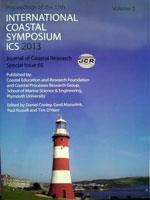Dreier, N., Schlamkow, C., Fröhle, P. and Salecker, D., 2013. Changes of 21st Century's average and extreme wave conditions at the German Baltic Sea Coast due to global climate change.
On the basis of hourly simulated wind data from a regional circulation model (Cosmo-CLM) long-term time series (1960–2100) of wave parameters were compiled for two of the SRES scenarios A1B, B1 at three locations along the German Baltic Sea Coast. The time series of wave parameters were calculated with the help of statistical correlations between observed wind and wave data, which were derived for the three locations in the study area. Furthermore, we applied a wave model for the Western Baltic Sea to correct some of the calculated wave information. The key findings of this study are that: (i) significant changes of average wind conditions can directly be linked to significant changes of the average wave conditions, (ii) a spatial pattern for the changes of average wave conditions can be found, (iii) no general trend can be found for the changes of extreme wave conditions. Comparisons of wind conditions, as simulated by the regional circulation model, for the past and the future are showing two main changes: (a) increases of average wind velocities to the end of the 21st century up to 4% and (b) more wind events from westerly and less events from easterly directions. The changes of the average wind velocities are resulting in increases of the average significant wave heights at westerly wind exposed locations up to 7% and small decreases of the average significant wave heights at easterly wind exposed locations. The future changes of the wave directions, with more wave events from W-NW and fewer events from N-NE, can be connected to the future changes of wind directions. Analyses of extreme wave heights with a return period of 200 years are showing both increasing and decreasing changes of up/down to /−14%. At one location of the study area (Warnemünde) a slight increasing trend for the change of extreme wave heights to the end of the 21st century exists.





